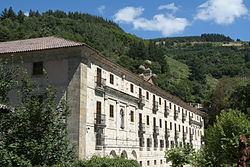
Alfonso II of Asturias, nicknamed the Chaste, was the king of Asturias during two different periods: first in the year 783 and later from 791 until his death in 842. Upon his death, Nepotian, a family member of undetermined relation, attempted to usurp the crown in place of the future Ramiro I.

The Kingdom of Asturias was a kingdom in the Iberian Peninsula founded by the Visigothic nobleman Pelagius. It was the first Christian political entity established after the Umayyad conquest of Visigothic Hispania in 711. In the Summer of 722, Pelagius defeated an Umayyad army at the Battle of Covadonga, in what is retroactively regarded as the beginning of the Reconquista.

Asturias officially the Principality of Asturias, is an autonomous community in northwest Spain.

Ramiro I was king of Asturias from 842 until his death in 850. Son of King Bermudo I, he became king following a succession struggle after his predecessor, Alfonso II, died without children. During his turbulent reign, he fended off attacks from both Vikings and the forces of al-Andalus. Architecturally, his recreational palace Santa María del Naranco and other buildings used the ramirense style that prefigured Romanesque architecture. He was a contemporary of Abd ar-Rahman II, Umayyad Emir of Córdoba.

San Vicente de Oviedo is a church and monastery in Oviedo, Spain. Its foundation in 761 is recorded in a charter known as the Pacto monástico de Oviedo. A copy made in the 12th century of the original that is dated 25 November 781 is considered the earliest document on the monarchy of the Kingdom of Asturias, although doubts exist as to the veracity of this document since the monastery, also called Antealtares in the Middle Ages, is not mentioned again until 969.
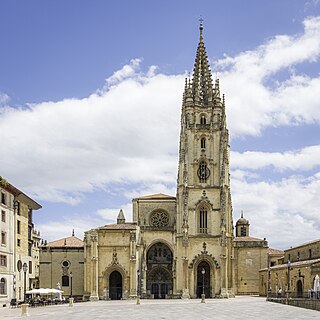
The Metropolitan Cathedral Basilica of the Holy Saviour or Cathedral of San Salvador is a Roman Catholic church and minor basilica in the centre of Oviedo, in the Asturias region of northern Spain.

Luis Alfonso de Carvallo, S.J., also known as "Padre Carvallo", was a priest and an important Asturian historian of the 16th and 17th centuries.

The Church of Saint Thyrsus is a Roman Catholic Asturian Romanesque church situated in Oviedo, in Asturias, northern Spain. The church was established in the 790s. Dedicated to Saint Thyrsus, it was built by Tioda, the royal architect of Alfonso II of Asturias. The Great Fire of Oviedo in 1521 and rebuilding in the 18th century removed most of the original church, except for a three-light window.

St. Mary of Bendones is an Asturian Pre-Romanesque Roman Catholic church situated in Bendones, Spain, build between 792 and 842.

The Church of Santo Adriano de Tuñón is a Roman Catholic Pre-Romanesque church in the village of Tuñón, Asturias, Spain dedicated to Saint Adrian.

The Holy chamber of Oviedo is a Roman Catholic pre-Romanesque church in Oviedo, Spain, built next to pre-romanesque Tower of San Miguel of the city's cathedral. Nowadays, the church occupies the angle between the south arm of the cathedral transept and a side of the cloister.
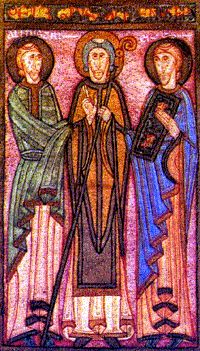
Pelagiusof Oviedo was a medieval ecclesiastic, historian, and forger who served the Diocese of Oviedo as an auxiliary bishop from 1098 and as bishop from 1102 until his deposition in 1130 and again from 1142 to 1143. He was an active and independent-minded prelate, who zealously defended the privileges and prestige of his diocese. During his episcopal tenure he oversaw the most productive scriptorium in Spain, which produced the vast Corpus Pelagianum, to which Pelagius contributed his own Chronicon regum Legionensium. His work as a historian is generally reliable, but for the forged, interpolated, and otherwise skilfully altered documents that emanated from his office he has been called el Fabulador and the "prince of falsifiers". It has been suggested that a monument be built in his honour in Oviedo.
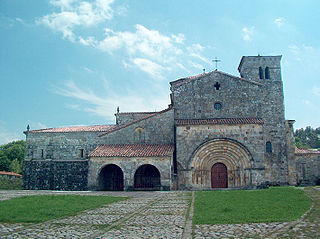
Fernando Díaz was a Spanish nobleman and military leader in the Kingdom of León, the most powerful Asturian magnate of the period. He held the highest rank in the kingdom, that of count, from at least 24 September 1089. He was the last Count of Asturias de Oviedo and was succeeded by a castellan, a novus homo, perhaps in an ecclesiastical–royal effort to curtail the power of the Asturian aristocracy.

Suero Vermúdez was an Asturian nobleman, territorial governor, and military leader. His career was marked by loyalty to the crown of León-Castile during the reigns of Alfonso VI, Urraca, and Alfonso VII. He never took part in any revolt, but fought in many wars against rebels, against rivals, and against the Moors.

San Antolín de Bedón is a church in Llanes, Asturias, Spain. The church was established in the 13th century. It located near the Monasterio de San Salvador (Celoriu) at the mouth of the River Bedón that divides in two the beach of San Antolin. Being a work with Cistercian construction features, it hardly presents any ornamentation.

Monasterio de San Salvador in Cornellana is a monastery located in Cornellana, municipality of Salas in Asturias, Spain.

The Pantheon of Asturian Kings is a chapel of Nuestra Señora del Rey Casto in the Cathedral of San Salvador, Oviedo, Spain. It is the burial place of many of the rulers of the medieval kingdoms of Asturias and León.

Cristina Bermúdez was an infanta of León, daughter of King Bermudo II and his first wife Queen Velasquita Ramírez. On her father's side, her grandparents were Ordoño III and Queen Urraca Fernández, daughter of count Fernán González of Castile. Her grandparents on her mother's side were most probably Count Ramiro Menéndez and his wife Adosinda Gutiérrez, both members of the highest Galaico-Portuguese nobility.
Ordoño Ramírez, called "the Blind" was the son of King Ramiro III of León and Sancha Gómez, grandson of Sancho I of León and Queen Teresa Ansúrez and, on the maternal side, of Gómez Díaz, Count of Saldaña and Countess Muniadona Fernández.
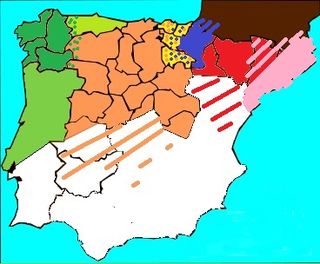
Spanish Romanesque designates the Romanesque art developed in the Hispanic-Christian kingdoms of the Iberian Peninsula in the 11th and 12th centuries. Its stylistic features are essentially common to the European Romanesque although it developed particular characteristics in the different regions of the peninsula. There is no Romanesque art in the southern half of the peninsula because it remained under Muslim rule (Al-Andalus). The examples of Romanesque buildings in the central area of the peninsula are sparse and of the latest period, with virtually no presence south of the Ebro and the Tagus. Most Romanesque buildings can be found in the northern third of the peninsula. Romanesque art was introduced into the peninsula from east to west, so scholars have usually defined regional characteristics accordingly: the "eastern kingdoms" comprising the Pyrenean areas, Catalan Romanesque, Aragonese Romanesque and Navarrese Romanesque, and the "western kingdoms" comprising Castilian-Leonese Romanesque, Asturian Romanesque, Galician Romanesque and Portuguese Romanesque.
